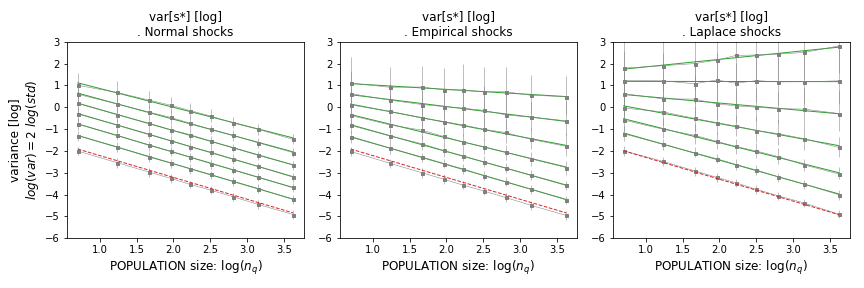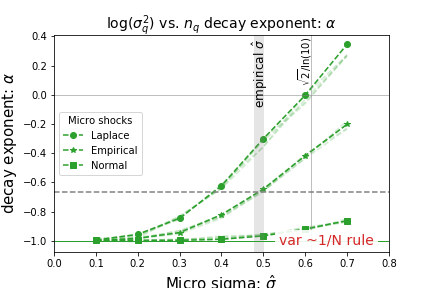Variance of Parts' Time Series Mean (The Law of Large Numbers)
Variance of Parts' Time Series Mean (The Law of Large Numbers)
In this section, we explore the variance of the time series mean for quantile levels, considering the implications of the law of large numbers.
We have postulated that the levels shown by a quantile are drawn from a hypothetical distribution . Although we do not know the specifics of this distribution, we can approximate its 'true' mean by averaging the levels shown by agents.
Variance Calculation
To determine the variance of this mean , consider and as time series of realizations of the observed average and observed fluctuations of agent at time step . The variance is given by:
Assuming the fluctuations for each are uncorrelated, i.e., , and the variance for each agent is roughly the same, , we find:
Thus, the variance of approximates to:
This is a 'law of large numbers' situation.
Computational Tests and General Expression
Computational tests reveal that the variance of parts' mean follows a more general expression:
with . This can be seen as a 'postponement' of the law of large numbers.

Figure: Variance of quantile levels as a function of , for various levels of micro fluctuations and . In the limit of small fluctuations, the LLN applies (red). As grows, variance decay with population size is milder, although still dominant.
Implications and Observations
The expression of the variance of mean of part vs. part's population as a power law with exponent aligns with the models of volatility vs. population size. If parts follow such a power law, then the aggregate inherits an average of their rate of decay. A power law for parts translates to an analogous 'large number postponement' power law for the idiosyncratic part of aggregate variance.
Mechanism Behind
The mechanism allowing to be smaller than 1 is illustrated in the following figure, which plots the parameter as a function of the width of micro fluctuations .

Figure: Decay rate of quantile variance with population size as a function of width of micro shocks . The bottom level implies fast law of large number convergence.
The observed values of depart from the naive diversification rule, where variance falls as . As increases, departs from , especially for fat-tailed distributions like log-Laplace. In empirical scenarios, firm-level shocks are large, suggesting , largely independent of mean micro shocks .
In summary, while the law of large numbers provides a baseline for understanding variance decay, real-world data and computational tests suggest more complex dynamics, particularly in the presence of significant micro fluctuations.